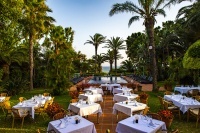
A tower of the Castle of Guzman El Bueno, originally built as an alcazar (Moorish fortress). |
|
Castle of Guzman EL Bueno
This impressive, solidly-built Moorish fortification, which played an important part in early Spanish history, has been restored. As the southern-most point of the peninsula, Tarifa was an important strategic entry point into Spain and the rest of Europe for would-be invaders, so good defensive structures were essential.
The Castle of Guzman El Bueno was originally built as an alcazar (Moorish fortress) in 960 AD on the orders of Caliph Abderraman III of Cordoba, to protect Tarifa against raids from Africa and the North (Vikings). This Caliph also constructed a number of defences along the Iberian coast, typically square castles in the style of the official Umayyad state architecture, but the Tarifa one is trapezoidal due to the hill's contours. The castle was restored and refortified in the 1760s when King Charles III instigated a plan to defend the Mediterranean coast with Watchtowers and forts againt the Barbary Pirates. The castle was refortified again by the local resistance forces against the French Troops in the 1808 to 1814 Guerra de la Independencia (Peninsular War)
Tarifa - built in the Moorish style, set in subtropical gardens leading down to the unspoilt beach.
Stylish & contemporary hotel close to unspoilt beaches. Gardens and large pool. Ideal for families.
Fast 45 min Ferry service, Tarifa to Tanger Ville, choice of two operators. Ideal for exploring Tanger town including day trips. Choose Algeciras to Tanger Med for road trip south in Morocco.
The castle is now named after Alonso Perez de Guzman, who famously defending it from the Marinids (Moors) in the siege of 1294, when he sacrificed his son's life to save the town, and was given the title Duke of Medina Sidonia by the King (and named El Bueno, which means the Righteous rather than the Good) as a reward. Afterwards the castle was used as a garrison for Spanish troops over many centuries.

Due to the castle's irregular oblong shape, some believe it was built on the remains of a Roman fort. To the east, two high towers protect the castle - one is called Torre de Guzman El Bueno; the order for the Moors to kill Guzman's son was given from here. Outside the castle you can see a statue of the king who first reconquered the town from the Moors in 1292, Sancho IV; there's a statue of Guzman himself just over the road on the Alameda.
Inside the castle you can see a small display on the life of Guzman himself; walk around the interior part of the castle and you'll find archways, stairs, gates and towers from various periods, and even a chapel. Climb up to the ramparts for impressive views over the sea to Morocco; there's a scale replica of a catapult, an important weapon in medieval times. In summer concerts are staged inside the castle.
Castle Visit
In the centre of the modern-day entrance courtyard is the 14th-century Puerta del Mar (Sea Gate). The arch's ray-form stones are Gothic but the rectangular hood mould or the tiles are mudejar. Until relatively recently this was the entrance to the city from the harbour - after climbing the very steep slope one had to pass through both this arch and the present entrance.
Just inside the Puerta del Mar (Sea Gate) are the ruins of a Christian chapel, which would have been the first building you saw when entering the city and a natural place to pray for protection for those at sea. It was only rediscovered in 1994 during archeological excavations, although 19th century engravings show a structure in ruins with an arched entrance.
The original tenth-century Califal castle was surrounded by an Almohad outer wall called barbacana in the 12th & 13th century. The entrance through this wall is via a defensive winding or 'zig- zag' gate. The Christians later added the entrance arch in front. As you pass through the gate, note the handy openings in the ceiling for throwing sharp objects at unwelcome guests.
Once through the gate, in spite of the steep steps and low handrail, it's worth making the effort to climb up onto the outer walls where you walk over the winding gate and along the Coracha curtain wall to the Torre de Guzman or Octagonal Tower, at the extreme western point, for the best view of the castle itself, the Alameda and the port. The tower is octagonal in plan and was probably originally even taller than it is today.
Return back along the walls and descend the stonesteps to visit the Califal inner castle, now an interpretation center. Over the entrance door note the original tenth-century plaque in Arabic. This is the English translation:
"In the name of the God of mercy and clemency
Praise be to God, Lord of the Universe,
God to Mohammed, the last of the prophets.
The servant of God, Abderramán
Emir Almuminin, may his life be blessed by the Lord,
ordered this fortress to be built. It was completed
in the month of Safar in the year 349,
having assisted in the construction, the Vizir
Abderramán ben Bahr, a client of his."
Inside the interpretation center climb to the first floor and follow a maze- like route to read about Guzman the Bueno, History of Artilery, the castle, Tarifa, Strait of Gibraltar.
Complete the visit of the inner castle by descending into the Patio de las Armas which is still to be full excavated and exit through the west gate.
In the rear part of the castle is the recently-restored gothic Iglesia de Santa Maria, which was built in the 14th century, although it has the form of an Islamic 'qubba' . Near the altar you can see large Roman walls under the glass floor, like a crypt, although no tombs were found there. Graves were found in long 'streets' separated by small walls in the nave of the church which was added later.
In the church you can also see the one-metre-thick Roman wall which must have supported a great public building such as a temple. A Bronze-age ceramic dating from 2,000 BC was uncovered here in a black sand and next to it was a small spherical stone and haematite grinder with the reddish mineral used in cave painting in the area.
Next to the church is the Pósito (granary or grain store) The Pósito was also an institution run by the local government to provide grain to farm workers in difficult times and to regulate the wheat market price. Tarifa´s granary dates from the XVIII Century and is constructed with large naves covered with arches and vaults in the ground floor. It is not open to the public and presently houses the local television station. In the courtyard between the church and Posito is a modern gate to Plaza de la Ranita (only open for special events) .
If you take a ferry from Tarifa port, which is located directly in front of the castle, stand on the small deck outside at the back of the ship for a great view back to the old town, with the Moorish fortress towering protectively over it.
Admission
Summer (until 15th of September):
Wednesday and Thursday from 10:00 to 15:00.
Friday and Saturday from 10:30 to 13:30 and from 18:30 to 21:30
Sunday from 10:00 a.m. to 3:00 p.m.
Monday and Tuesday closed.
Winter:
Tuesday to Sunday from 10:00 a.m. to 4:00 p.m.
Closed Monday.
Guided tours at 12.00 hrs.
Notice: Access ends 45 minutes before the monument is closed
Ticket options are: Castle and Interpretation Centre: General 4€
Castle and City Walls: General 5€
City Walls only: General 2€
Adults: 4 €
Children 12 yrs to under 18 yrs: 2.50 €
Children under 12 yrs: Free
Pensioners, Students, Disabled: 1.50€
Free Admission Sundays, last two hours.






